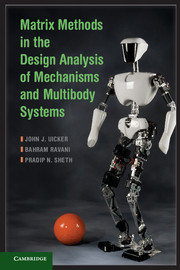Book contents
- Frontmatter
- Contents
- Preface
- About the Authors
- 1 Concepts and Definitions
- 2 Topology and Kinematic Architecture
- 3 Transformation Matrices in Kinematics
- 4 Modeling Mechanisms and Multibody Systems with Transformation Matrices
- 5 Posture Analysis by Kinematic Equations
- 6 Differential Kinematics and Numeric Solution of Posture Equations
- 7 Velocity Analysis
- 8 Acceleration Analysis
- 9 Modeling Dynamic Aspects of Mechanisms and Multibody Systems
- 10 Dynamic Equations of Motion
- 11 Linearized Equations of Motion
- 12 Equilibrium Posture Analysis
- 13 Frequency Response of Mechanisms and Multibody Systems
- 14 Time Response of Mechanisms and Multibody Systems
- 15 Collision Detection
- 16 Impact Analysis
- 17 Constraint Force Analysis
- Index
- References
3 - Transformation Matrices in Kinematics
Published online by Cambridge University Press: 05 April 2013
- Frontmatter
- Contents
- Preface
- About the Authors
- 1 Concepts and Definitions
- 2 Topology and Kinematic Architecture
- 3 Transformation Matrices in Kinematics
- 4 Modeling Mechanisms and Multibody Systems with Transformation Matrices
- 5 Posture Analysis by Kinematic Equations
- 6 Differential Kinematics and Numeric Solution of Posture Equations
- 7 Velocity Analysis
- 8 Acceleration Analysis
- 9 Modeling Dynamic Aspects of Mechanisms and Multibody Systems
- 10 Dynamic Equations of Motion
- 11 Linearized Equations of Motion
- 12 Equilibrium Posture Analysis
- 13 Frequency Response of Mechanisms and Multibody Systems
- 14 Time Response of Mechanisms and Multibody Systems
- 15 Collision Detection
- 16 Impact Analysis
- 17 Constraint Force Analysis
- Index
- References
Summary
Introduction
Before formulating a numeric method for design analysis of mechanisms and multibody systems, let us first consider the essential characteristics of the problem being addressed. What are the chief difficulties encountered in the design analysis of a mechanism or multibody system? It is not the laws of mechanics as such that cause difficulty. It is the fact that, once a problem has been formulated, it is often too formidable algebraically to be easily solved. This complexity does not arise from static and dynamic force relationships, but from the kinematics – the changing geometry. The basic constraint equations that govern the motions within a machine or multibody system come from the fact that rigid bodies hold their respective joint elements in constant spatial relationships to one another. This type of constraint invariably leads to a set of highly nonlinear simultaneous algebraic equations.
Because the difficulties in an analytic approach to mechanism and multibody system analysis stem from the geometry, it is wise to choose a mathematical formulation suited to this type of problem. One such formulation is based on the use of matrices to represent the transformation equations between strategically located coordinate systems fixed in successive bodies. This approach has been developed into an extremely general and powerful technique for mechanism and multibody system analysis, and the next several chapters are devoted to its presentation. Before this can be presented effectively, however, we must become familiar with a number of basic operations that render matrix algebra so useful in performing coordinate transformations. The purpose of this chapter, therefore, is to develop this foundation.
- Type
- Chapter
- Information
- Publisher: Cambridge University PressPrint publication year: 2013



